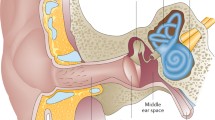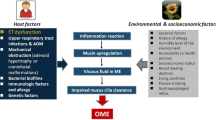Abstract
Acute otitis media (AOM) and otitis media with effusion (OME) in children can present with a variety of middle ear effusions (MEE). Even though the character of the effusion may vary, the underlying pathogenesis is often similar. In the last decade, there has been an abundance of new information in the fields of immunobiology and immunochemistry to explain the chronicity of MEE. There are also studies examining the efficacy of vaccination and immunoprophylaxis for recurrent AOM. Diagnosis of otitis media (OM) in a child can be difficult but good visualization by pneumatic otoscopy improves the accuracy of diagnosis of OME. The development of increasing bacterial resistance to antimicrobial therapy reinforces the need to be more rational in treating AOM and OME. The variability of the natural history and the long term sequelae of OME makes medical management more difficult. All children with chronic MEE should have audiologic evaluation. Surgery is recommended should the condition be refractory to medical therapy or if the complications of MEE develop.
Similar content being viewed by others
References
Gates, GA. Cost-efectiveness considerations in otitis media treatment.Otolaryngol Head Neck Surg. 1996; 114: 525–530.
Swanson JA, Hoecker, JL. Concise review for primary care physicians: otitis media in young children.Mayo Clin Proc. 1996; 71 :179–183.
Weiss JC, Yates GR, Quinn LD. Acute otitis media: making an accurate diagnosis.Am Fam Physic 1996; 53 :1200–1206.
Doyle WJ and Seroky JT. Middle ear gas exchange in rhesus monkeys.Ann Otol Rhinol Laryngol. 1994; 103: 636–645.
Juhn SK, Garivs WJ, Lees CJet al. Determining otitis media severity from middle ear fluid analysis.Ann Otol Rhinol Laryngol 1994; 103: 43–45.
Giebink GS. Preventing otitis media.Ann Otol Rhinol Laryngol. 1994; 103: 20–23.
Shurin PA, Rehmus JM, Johnson CE,et al. Bacterial polysaccharide immunoglobulin for prophylaxis of acute otitis media in high-risk children.J Pediatr, 1993; 123: 801–810.
Berstein JM, Szymanski C, Albini B,et al. Lymphocyte subpopulations in otitis media with effusion.Pediatr Res. 1978; 12: 786–788.
Goycoolea MV, Paparella MM, Juhn SK, Carpenter, A. Otitis media with perforation of the tympanic membrane: A longitudinal experimental studyLaryngoscope. 1980; 90:2037–2045.
Bluestone CD, Sephenson JS, Martin BS, Martin L. Ten year review of otitis media pathogens.Pediatr infect Dis J. 1992; 11: S7-S11.
Post JC, Preston RA, Aul JJ.et al. Molecular analysis of bacterial pathogens in otitis media with effusion.JAMA. 1995; 273: 1598–1604.
Nozza RJ, Bluestone CD, Kardatzke D, Bachman RN. Identification of middle ear effusion by aural acoustic admittance and otoscopy.Ear Hear 1992; 13: 442.
Teele DW, Klein JO, Rosner B,et al. Epidemiology of otits media during the first seven years of life in children in Greater Boston: prospective cohort study.J Infect Dis 1989; 160 : 83–94.
Gravel JS, Wallace IF, Ruben RJ. Early otitis media and later educational risk.Acta Otolaryngol (Stockh) 1995; 115: 279–281.
Fenoll A, Bourgon CM, Munoz R.et al. Serotype distribution and antimicrobial resistane inStreptococcus pneumoniae isolates causing systemic infections in Spain 1979-1989.Rev Infect Dis 1991; 13: 56–60.
Mastro TD, Ghafoor A, Nomani NKet al., Antimicrobial resistance of pneumococci in children with acute lower respiratory tract infections in Pakistan.Lancet 1991; 337:156–159.
Paradise JL. Managing otitis media: a time for change.Pediatrics 1995; 96 : 712–715.
Cantekin El, Mandel EM, Bluestone CDet al. Lack of efficacy of a decongestant-antihistamine combination for otitis media with effusion in children.NEJM 1983; 308:297–301.
Stillwagon PK, Doyle WJ, Fireman P. Effect of an antihistamine decongestant on nasal and eustachian tube dysfunction following intranasal pollen challenge.Ann Allergy 1987; 58: 442–446.
Gates GA, Avery CA, Prihoda TJet al. Effectiveness of adenoidectomy and tympanostomy tubes in the treatment of chronic otitis media with effusion.NEJM 1987; 317:1444–1451.
Author information
Authors and Affiliations
Rights and permissions
About this article
Cite this article
Cheng, A.T.L., Young, N.M. Middle ear effusion in children. Indian J Pediatr 64, 755–761 (1997). https://doi.org/10.1007/BF02725496
Issue Date:
DOI: https://doi.org/10.1007/BF02725496




